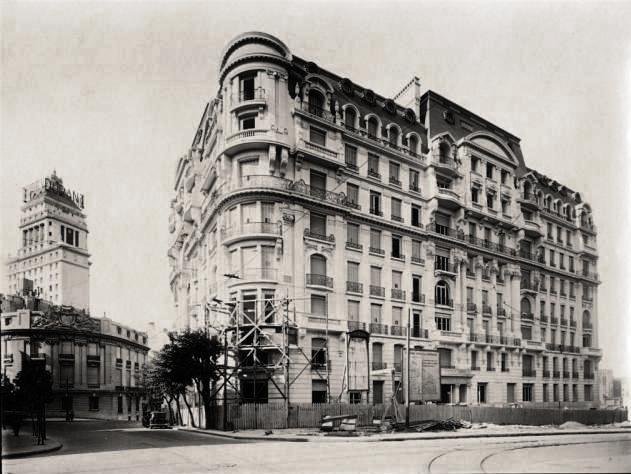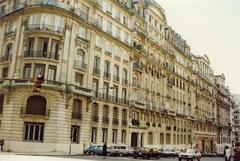
Estrugamou Building Buenos Aires: Visiting Hours, Tickets, and Historical Significance
Date: 15/06/2025
Introduction
Situated in Buenos Aires’ prestigious Retiro neighborhood, the Estrugamou Building (Edificio Estrugamou) is a celebrated icon of French Beaux-Arts architecture and cultural sophistication. Commissioned in the 1920s by Alejandro Fernando Estrugamou, a prominent landowner of Basque-French heritage, the building reflects the cosmopolitan ambitions of Argentina’s elite during a pivotal era of urban development. Its ornate facades, mansard roofs, and central courtyard—featuring a replica of the “Winged Victory of Samothrace”—evoke Parisian grandeur transplanted to South America. Notably, the building has been home to influential figures such as Carlos Gardel and former president Marcelo Torcuato de Alvear, further cementing its legacy as a cultural landmark. This comprehensive guide explores the Estrugamou Building’s history, architecture, visitor information, and enduring cultural significance for anyone seeking to understand or experience Buenos Aires’ aristocratic past (Buenos Aires Tourism Website, The Collector, Toribio Achával).
Table of Contents
- Introduction
- Historical Background and Evolution
- Architectural Features and Artistic Elements
- The Estrugamou Family Legacy
- Cultural Significance and Contemporary Use
- Practical Visitor Information
- Notable Residents
- Nearby Attractions
- Frequently Asked Questions (FAQ)
- Visual Media Recommendations
- Additional Resources
- Conclusion and Call to Action
- References
Historical Background and Evolution
Origins and Commissioning
Commissioned in 1924 by Alejandro Fernando Estrugamou Larrat, the Estrugamou Building was envisioned as a prestigious rental property in the heart of Buenos Aires’ “aristocratic bend” at 783 Juncal Street. The Retiro neighborhood, at the time, was synonymous with affluence and housed many of the city’s most elegant residences.
Architectural Style and Influences
The building is a quintessential example of French Beaux-Arts architecture, characterized by symmetrical facades, mansard roofs, intricate wrought-iron balconies, and elaborate stonework (Toribio Achával). Its design, by Eduardo Sauze and Auguste Huguier, also integrates Art Nouveau and Art Deco motifs, visible in the geometric ironwork and decorative patterns. The complex comprises four interconnected eight-story towers, arranged around a central courtyard that amplifies natural light and ventilation.
Social and Urban Context
Erected during Buenos Aires’ Belle Époque, the Estrugamou Building symbolized the transition from grand mansions to luxury apartments, mirroring trends in European capitals. Its proximity to Plaza San Martín and major diplomatic missions further increased its cachet among the Argentine elite (Everything Explained Today).
Notable Features and Artistic Elements
A hallmark of the building is its central courtyard, where a bronze replica of the “Winged Victory of Samothrace” is displayed—a nod to classical European art. The building’s interior spaces were designed for refined living: high ceilings, hardwood floors, French chandeliers, intricate plasterwork, and private vestibules. Materials such as Italian marble and French-Spanish ironwork were imported, showcasing the craftsmanship and attention to detail (Para Ti).
Restoration and Modern Adaptations
A significant restoration in 1940 updated the apartments for modern living while preserving their original elegance. Kitchens were repositioned, and layouts were adapted to contemporary needs, ensuring the building’s continued relevance.
The Estrugamou Family Legacy
The Estrugamou family contributed notably to Argentine society, particularly in education and philanthropy; Eva Perón is among the alumni of one of their founded schools (Tierra del Fuego 24). Their legacy is intertwined with the building’s ongoing status as a symbol of prestige and benevolence.
Cultural Significance and Contemporary Use
Today, the Estrugamou Building stands as a protected architectural heritage site and occasional venue for cultural events, such as the Casa FOA interior design exhibition. Though primarily a private residence, its artistic and historical value continues to draw attention from architecture enthusiasts and cultural historians (Para Ti).
Practical Visitor Information
Location and Accessibility
- Address: Juncal 783 (corner of Esmeralda), Retiro, Buenos Aires (La Nación)
- Getting There: Close to Retiro subway station (Line C) and multiple bus lines. Taxis and ride-sharing apps are also convenient.
Visiting Hours and Entry
- Exterior Viewing: The building’s impressive facade and courtyard can be admired from the street at any time.
- Interior Access: Generally restricted to residents. Interior visits are occasionally possible during cultural events such as “Open House Buenos Aires” or through private tours organized by heritage groups (Joy of Buenos Aires).
- Guided Tours: Offered sporadically by local tour operators; advance booking is required.
Visitor Tips
- Photography: Permitted for the exterior; avoid photographing residents or attempting unauthorized entry.
- Best Time to Visit: Early morning or late afternoon for optimal lighting.
- Safety: Retiro is generally safe during the day; practice usual urban precautions.
- Language: Spanish is the official language, but English-speaking guides are available through tour operators.
Accessibility
- Sidewalks are suitable for wheelchairs and strollers; however, interior accessibility is limited due to the building’s historic structure.
Costs
- Exterior viewing is free. Tours with interior access (when available) typically cost USD 20–50.
Notable Residents
The Estrugamou Building has been home to numerous distinguished figures:
- Carlos Gardel: Legendary tango singer, who lived here in the 1930s (Billiken).
- Marcelo Torcuato de Alvear: Former Argentine president.
- Domingo Cavallo: Ex-Minister of Economy.
- Jorge Lanata: Renowned journalist (Toribio Achával).
The building’s reputation for luxury and discretion has attracted diplomats, artists, and leading business figures, enhancing its mystique (Everything Explained Today).
Nearby Attractions
- Plaza San Martín: A historic park and local landmark.
- Palacio Paz: Another example of Belle Époque architecture.
- Kavanagh Building: An Art Deco skyscraper.
- Torre Monumental and Teatro Colón are also within easy walking distance.
Frequently Asked Questions (FAQ)
Can I visit the Estrugamou Building’s interior?
Generally, no. Interior access is limited to residents, but rare opportunities arise during special events or with private tour operators.
What are the building’s visiting hours?
The exterior can be viewed at any time. There are no regular public hours for the interior.
Are guided tours available?
Yes, occasionally via local heritage groups or during Open House Buenos Aires. Advance booking is essential.
Is there a ticket or entry fee?
There is no fee for exterior viewing. Guided tours (when available) are fee-based.
Is the building accessible for those with mobility issues?
The exterior is accessible; interior access may be limited due to historic design.
Visual Media Recommendations
To experience the building’s architecture virtually, explore high-quality images and virtual tours available on the Buenos Aires Tourism Website or through local cultural heritage organizations.
Additional Resources
- Official Buenos Aires Tourism Website
- Buenos Aires Ministry of Culture Events
- Palacio Estrugamou Wikipedia page
- Joy of Buenos Aires Tours
Conclusion and Call to Action
The Estrugamou Building remains a striking emblem of Buenos Aires’ golden age, marrying European architectural sophistication with Argentina’s unique urban identity. While its interiors are rarely accessible, its exterior splendor and storied past offer a rewarding glimpse into the city’s aristocratic heritage. For those eager to delve deeper, stay informed about special events and guided tours through the Buenos Aires Ministry of Culture and official tourist portals. Enhance your Buenos Aires experience by downloading the Audiala app for personalized guides and up-to-date information on the city’s architectural gems.
Summary Table: Key Visitor Information
| Aspect | Details |
|---|---|
| Location | Juncal & Esmeralda, Retiro, Buenos Aires |
| Access | Exterior: Public; Interior: By special arrangement only |
| Nearest Subway | Retiro (Line C), San Martín (Line C), General San Martín (Line D) |
| Guided Tours | Available via local operators; advance booking recommended |
| Best Visiting Hours | Daylight, especially morning or late afternoon for photography |
| Entry Fee | None for exterior; tour prices vary |
| Accessibility | Good for mobility-impaired visitors (exterior only) |
| Safety | Safe area; standard urban precautions advised |
| Language | Spanish (English-speaking guides available via tour operators) |
| Amenities | Cafés, shops, and restrooms available nearby |
| Special Events | Open House Buenos Aires (annual, check dates for interior access opportunities) |
For current details, consult local tour operators or the Buenos Aires tourism website.
References
- Buenos Aires Tourism Website
- The Collector – History Lover’s Guide to Buenos Aires
- Toribio Achával – Edificio Estrugamou
- La Nación – Palacio Estrugamou
- Buenos Aires Ministry of Culture Events
- Everything Explained Today – Estrugamou Building
- Para Ti – Estrugamou, el Palacio Icónico
- Billiken – Palacio de Lujo
- Tierra del Fuego 24 – Palacio Estrugamou
- Joy of Buenos Aires
- Plaza San Martín
- Palacio Paz
- Kavanagh Building






























































































































































